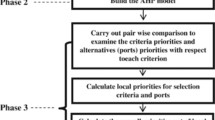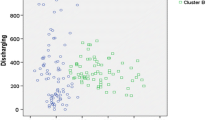Abstract
This paper presents the results of an empirical study conducted by distributing questionnaires to shipping agents working for foreign principals in Karachi, Pakistan. In Part A of the questionnaire, respondents gave a score reflecting the importance of 13 factors affecting terminal selection. Their responses indicate that service quality, loading/discharging rate and handling charges are the most important selection factors. A linear model is developed in which the dependent variable is total stay (in hours). The independent variables are vessel type, vessel size, total TEUs (twenty-foot equivalent units), vessel frequency and past visits of the shipping line. All the coefficients are significant. In the second section (that is, Part B of the questionnaire), respondents gave scores reflecting the quality of different attributes and how they affect the attractiveness of four specific container terminals. One-way ANOVA was used to test whether respondents have significant opinion differences. The result indicated that respondents do differ in opinions. Moreover, factor analysis of the aggregate data produced two factors with strong loading of six attributes in one factor and two attributes in the second.






Similar content being viewed by others
Notes
The public terminal does not have any specific name like KICT, PICT. In the official record of Karachi port authority, it is written ‘Geared Vessels’, probably because only geared vessels call at this terminal. For simplicity, it is mentioned as KPT in this paper.
These are total containers contained in a vessel of one shipping line.
Status of containers can be checked on the websites of KICT, PICT, but in QICT, in addition to website, customer can check it by sending SMS.
For example, some shipping companies have invested in terminals by building their own yards, such as Cowasjee, Seaboard etc who have their own CFS facility/yard. Containers are kept, cargo stuffed, consoled and, when ships arrive, transported for shipping on board the vessel. In this way they have invested in a particular terminal, so when and if they decide to switch to another terminal, they have to bear the cost of losing of what they have invested.
See Moorad Shipping News, 23 March 2006. Bi-Weekly published since 1956.
Two questionnaires were filled out by one shipping agent on behalf of his two different principals, considered as two different responses. Two questionnaires were filled out by the same shipping agency, but by different people and at different times, one in August 2007, during a pilot survey, and the second in November 2007, so they are considered as two different responses.
See www.qict.net
See Appendix for Collinearity Statistics.
References
Bartlett, M.S. (1954) A note on the multiplying factors for various chi square approximations. Journal of the Royal Statistical Society 16: 296–298.
Bird, J. (1988a) Freight forwarders speak: The perception of route competition via seaports in the European communities research project (Part 1). Maritime Policy and Management 15 (1): 35–55.
Bird, J. (1988b) Freight forwarders speak: The perception of route competition via seaports in the European communities research project (Part 11). Maritime Policy and Management 15 (2): 153–172.
Blonigen, B.A. and Wilson, W.W. (2006) International trade, transportation networks and port choice manuscript, http://www.aeaweb.org/annual_mtg_papers/2007/0105_1430_2103.pdf.
Catell, R.B. (1966) The scree test for number of factors. Multivariate Behavioral Research 1 (2): 245–276.
Containerization International Yearbook, 2007. UK: Informa Maritime & Transport.
de Langen, W.P. (2007) Port competition and selection in contestable hinterlands: The case of Austria. European Journal of Transport and Infrastructure Research 7 (1): 1–14.
Eddington, A. (1935) New Pathways in Science. New York: The Macmillan Company.
Frankel, E.G. (1987) Port Planning and Development. New York: John Willly & Sons.
Ha, M-S. (2003) A comparison of service quality at major container ports: Implications for Korean ports. Journal of Transport Geography 11 (2): 131–137.
Heide, J.B. and Weiss, A.M. (1995) Vendor consideration and switching behavior for buyers in high technology markets. The Journal of Marketing 59 (3): 30–43.
Kaiser, H. (1970) A second generation Little Jiffy. Psychometrika 35 (4): 401–415.
Kaiser, H. (1974) An index of factorial simplicity. Psychometrika 39: 31–36.
Lee, Y. and Hsu, N-Y. (2007) An optimization model for the container pre-marshalling problem. Computers and Operations research 34 (11): 3295–3313.
Lirn, T.C., Thanopoulou, H.A., Beynon, M.J. and Beresford, A.K.C. (2004) An application of AHP on transhipment port selection: A global perspective. Maritime Economics and Logistics 6 (1): 70–91.
Macneil, I.R. (1978) Contracts: Adjustments of long-term economic relations under classical, neo-classical and relational contract law. Northwestern University Law Review 72 (6): 854–902.
Macneil, I.R. (1980) The New Social Contract: An Inquiry into Modern Contractual Relation. London: Yale University Press.
Malchow, B.M. and Kanafani, A. (2004) A disaggregate analysis of port selection. Transportation Research Part E: Logistics and Transportation Review 40 (4): 317–337.
Murphy, P.R. and Daley, J.M. (1994) A comparative analysis of port selection factors. Transportation Journal 34 (1): 15–21.
Murphy, P.R., Daley, J.M. and Dalenberg, D.R. (1992) Port selection criteria: An application of a transportation research framework. Logistics and Transportation Review 28 (3): 237–255.
Ng, K.Y. (2006) Assessing the attractiveness of ports in the North European container transhipment market: An agenda for future research in port competition. Maritime Economics and Logistics 8 (3): 234–250.
Nir, A-S., Lin, K. and Liang, G-S. (2003) Port choice behaviour – from the perspective of the shipper. Maritime Policy and Management 30 (2): 165–173.
Owen, D. (1914) Ocean Trade and Shipping. Cambridge, MA: University Press.
Pallant, J. (2004) SPSS Survival Manual: A Step by Step Guide to Data Analysis Using SPSS for Windows, 2nd edn., Maidenhead, UK: Open University Press.
Powell, W.W. (1990) Neither market nor hierarchy: Network forms of organization. Research in Organizational Behavior 12: 295–336.
Sciomachen, A. and Tanfani, E. (2007) A 3D-BPP approach for optimising stowage plans and terminal productivity. European Journal of Operational Research 183 (3): 1433–1446.
Slack, B. (1985) Containerization, inter-port competition and port selection. Maritime Policy and Management 12 (4): 293–230.
Tiwari, P., Itoh, H. and Doi, M. (2003) Containerized Cargo shipper's behavior in China: A discrete choice analysis. Journal of Transportation and Statistics 6 (1): 71–86.
Tongzon, J. (2002) Port Choice Determinants in a Competitive Environment, Proceedings of Annual Conference and Meeting of the International Association of Maritime Economists – IAME; Panama, http://www.eclac.cl/transporte/perfil/iame_papers/proceedings/Tongzon.doc.
Weiss, A. and Anderson, E. (1992) Converting from independent to employee sales forces: The role of perceived switching costs. Journal of Marketing Research 29: 101–115.
Williamson, O.E. (1985) The Economic Institutions of Capitalism. New York: Free Press.
Wilson, I.D. (2001) Container stowage pre-planning: Using search to generate solutions, a case study. Knowledge-Based Systems 14: 137–145.
Acknowledgements
An earlier version of this paper was presented at the International Association of Maritime Economists Conference (IAME) in Dalian, China, April 2008. I thank the anonymous reviewer for his valuable comments. Further, I am indebted to the two anonymous referees of MEL for productive comments that led to improvements in this paper.
Author information
Authors and Affiliations
Corresponding author
Appendix
Rights and permissions
About this article
Cite this article
Saeed, N. An analysis of carriers’ selection criteria when choosing container terminals in Pakistan. Marit Econ Logist 11, 270–288 (2009). https://doi.org/10.1057/mel.2009.8
Published:
Issue Date:
DOI: https://doi.org/10.1057/mel.2009.8




